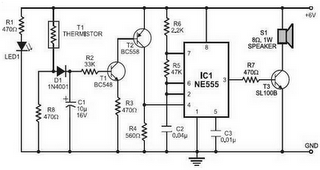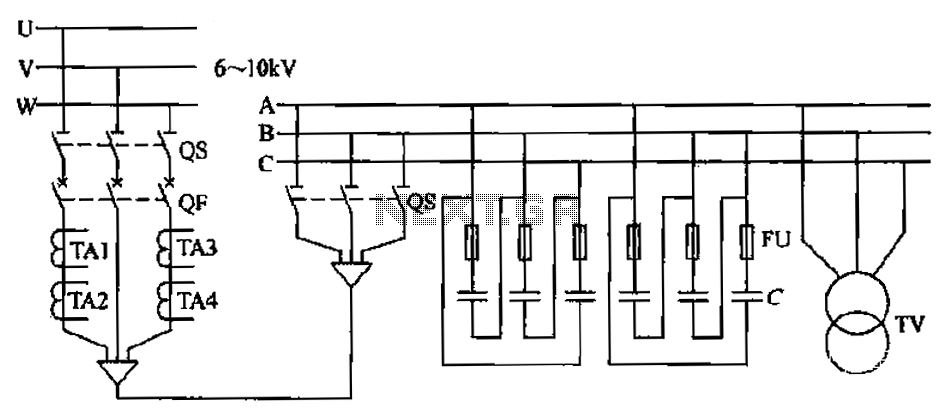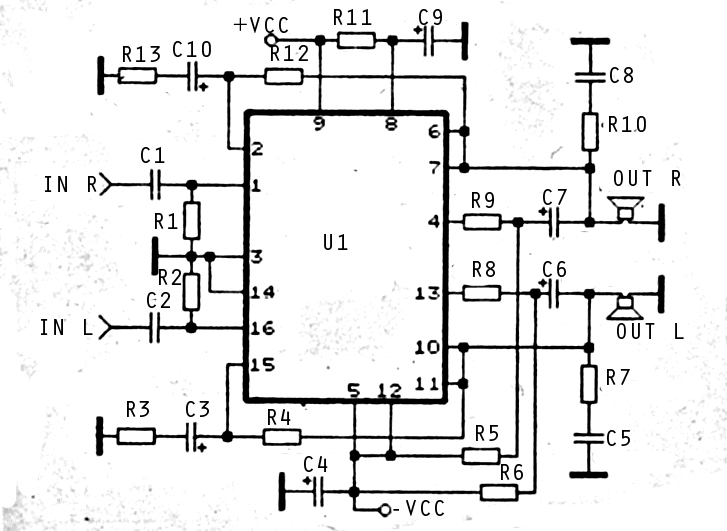
Fire Alarm Circuit using LDR (Light Depending Resistor)

Fire alarm circuit using an LDR (Light Dependent Resistor) as a flame sensor. It warns the user about fire accidents by detecting smoke produced during a fire. As smoke passes between an LED and an LDR, the amount of light falling on the LDR decreases. This results in a decrease in the resistance of the LDR, which causes the voltage at the base of the transistor to rise, activating the NE555 timer and subsequently triggering the alarm. The thermistor provides low resistance at high temperatures and high resistance at low temperatures, allowing it to detect fire. The IC1 (NE555) is configured as a free-running oscillator at audio frequency. Transistors T1 and T2 drive IC1. The output (pin 3) of IC1 is connected to the base of transistor T3 (SL100), which drives the speaker to produce an alarm sound. The frequency of the NE555 is determined by the values of resistors R5 and R6 and capacitor C2. When the thermistor gets hot, it creates a low-resistance path for the supply voltage to the base of transistor T1 through diode D1 and resistor R2. Capacitor C1 charges up to the supply voltage, increasing the duration for which the alarm is ON. The larger the value of C1, the longer the output activated at the base of transistor T1 (BC548). Since the collector of T1 is connected to the base of transistor T2, T2 provides a supply voltage to pin 4 (reset) of IC1 (NE555). Resistor R4 ensures that NE555 remains inactive in the absence of supply voltage. Diode D1 prevents the discharge of capacitor C1 when the thermistor is connected to the supply voltage and cools down, providing a high-resistance path, while also inhibiting the forward biasing of transistor T1.
The fire alarm circuit employs a combination of sensitive components to detect the presence of smoke and heat, activating an alarm signal to alert users of potential fire hazards. The LDR operates on the principle of photoconductivity, where its resistance decreases with an increase in light intensity, which is affected by smoke particles. The NE555 timer, configured in astable mode, generates a continuous square wave output that can be adjusted in frequency by varying the resistors and capacitor connected to it.
Transistors T1 and T2 serve as amplifiers and switches in the circuit. T1 is responsible for detecting changes in voltage at its base, which occurs when the thermistor heats up, indicating a fire. This change in voltage is crucial as it allows T1 to turn on T2, which in turn enables the NE555 timer to produce an audible alarm through T3. The alarm sound is crucial for alerting individuals in the vicinity of the fire.
Capacitor C1 plays a significant role in determining the response time of the alarm. By charging up to the supply voltage, it introduces a delay that allows the system to maintain the alarm state for a predetermined duration, even after the initial trigger condition has passed. This feature ensures that the alarm remains active long enough to alert anyone nearby, providing a critical safety margin.
The inclusion of a diode (D1) prevents unwanted backflow of current that could lead to false triggering of the alarm or damage to the components. Resistor R4 acts as a pull-down resistor to ensure that the NE555 timer remains inactive when not triggered, thus conserving power and preventing false alarms.
Overall, this fire alarm circuit design showcases a practical application of basic electronic components and principles to create an effective safety device capable of responding to fire emergencies. The careful selection of components and their configuration ensures reliable operation and timely alerts in the event of a fire.Fire Alarm Circuit using LDR (Light Depending Resistor) as ablaze sensor. It warns the user adjoin blaze accidents. It relies on the smoke that is produced in the accident of a fire. Back this smoke passes amid a LED and an LDR, the bulk of ablaze falling on the LDR decreases. This causes the attrition of LDR to access and the voltage at the abjec t of the transistor is pulled aerial due to which the accumulation to NE555 again activated the alarm. The thermistor offers a low attrition at aerial temperature and aerial attrition at low temperature. This abnormality is active actuality for analysis the fire. The IC1 (NE555) is configured as a chargeless active oscillator at audio frequency. The transistors T1 and T2 drive IC1. The achievement (pin 3) of IC1 is couples to abject of transistor T3 (SL100), which drives the apostle to accomplish anxiety sound.
The abundance of NE555 depends on the ethics of resistances R5 and R6 and capacitance C2. When thermistor becomes hot, it gives a low-resistance aisle for the absolute voltage to the abject of transistor T1 through diode D1 and attrition R2. Capacitor C1 accuse up to the absolute accumulation voltage and increases the the time for which the anxiety is ON.
The beyond the amount of C1, the beyond the absolute bent activated to the abject of transistor T1 (BC548). As the beneficiary of T1 is accompanying to the abject of transistor T2, the transistor T2 provides a absolute voltage to pin 4 (reset) of IC1 (NE555).
Resistor R4 is called s0 that NE555 keeps abeyant in the absence of the absolute voltage. Diode D1 stops absolution of capacitor C1 back the thermistor is in affiliation with the absolute accumulation voltage cools out and provides a aerial attrition path. It additionally inhibits the advanced biasing of transistor T1. 🔗 External reference
The fire alarm circuit employs a combination of sensitive components to detect the presence of smoke and heat, activating an alarm signal to alert users of potential fire hazards. The LDR operates on the principle of photoconductivity, where its resistance decreases with an increase in light intensity, which is affected by smoke particles. The NE555 timer, configured in astable mode, generates a continuous square wave output that can be adjusted in frequency by varying the resistors and capacitor connected to it.
Transistors T1 and T2 serve as amplifiers and switches in the circuit. T1 is responsible for detecting changes in voltage at its base, which occurs when the thermistor heats up, indicating a fire. This change in voltage is crucial as it allows T1 to turn on T2, which in turn enables the NE555 timer to produce an audible alarm through T3. The alarm sound is crucial for alerting individuals in the vicinity of the fire.
Capacitor C1 plays a significant role in determining the response time of the alarm. By charging up to the supply voltage, it introduces a delay that allows the system to maintain the alarm state for a predetermined duration, even after the initial trigger condition has passed. This feature ensures that the alarm remains active long enough to alert anyone nearby, providing a critical safety margin.
The inclusion of a diode (D1) prevents unwanted backflow of current that could lead to false triggering of the alarm or damage to the components. Resistor R4 acts as a pull-down resistor to ensure that the NE555 timer remains inactive when not triggered, thus conserving power and preventing false alarms.
Overall, this fire alarm circuit design showcases a practical application of basic electronic components and principles to create an effective safety device capable of responding to fire emergencies. The careful selection of components and their configuration ensures reliable operation and timely alerts in the event of a fire.Fire Alarm Circuit using LDR (Light Depending Resistor) as ablaze sensor. It warns the user adjoin blaze accidents. It relies on the smoke that is produced in the accident of a fire. Back this smoke passes amid a LED and an LDR, the bulk of ablaze falling on the LDR decreases. This causes the attrition of LDR to access and the voltage at the abjec t of the transistor is pulled aerial due to which the accumulation to NE555 again activated the alarm. The thermistor offers a low attrition at aerial temperature and aerial attrition at low temperature. This abnormality is active actuality for analysis the fire. The IC1 (NE555) is configured as a chargeless active oscillator at audio frequency. The transistors T1 and T2 drive IC1. The achievement (pin 3) of IC1 is couples to abject of transistor T3 (SL100), which drives the apostle to accomplish anxiety sound.
The abundance of NE555 depends on the ethics of resistances R5 and R6 and capacitance C2. When thermistor becomes hot, it gives a low-resistance aisle for the absolute voltage to the abject of transistor T1 through diode D1 and attrition R2. Capacitor C1 accuse up to the absolute accumulation voltage and increases the the time for which the anxiety is ON.
The beyond the amount of C1, the beyond the absolute bent activated to the abject of transistor T1 (BC548). As the beneficiary of T1 is accompanying to the abject of transistor T2, the transistor T2 provides a absolute voltage to pin 4 (reset) of IC1 (NE555).
Resistor R4 is called s0 that NE555 keeps abeyant in the absence of the absolute voltage. Diode D1 stops absolution of capacitor C1 back the thermistor is in affiliation with the absolute accumulation voltage cools out and provides a aerial attrition path. It additionally inhibits the advanced biasing of transistor T1. 🔗 External reference




